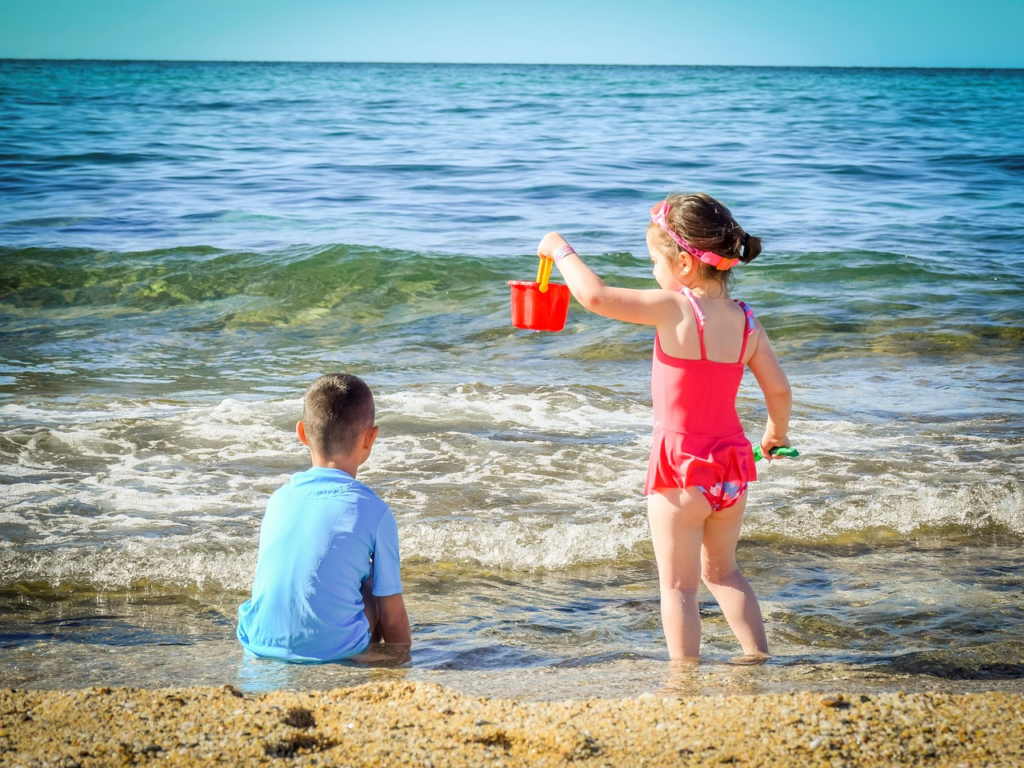Traveling with children can be an incredible and enriching experience for the whole family. However, we know that it can also be challenging. From planning activities to keeping the little ones entertained for long periods of time, traveling with children requires a little extra preparation and consideration. But with a few useful tips and a little creativity, you can turn your next trip into a memorable adventure for everyone.
15 tips for traveling with children and making the most of your destination
Traveling with children can be an exciting and enriching experience for the whole family. However, we know it can also be challenging. From planning activities to keeping the little ones entertained for long periods of time, traveling with children requires a little extra preparation and consideration. But with a few useful tips and a little creativity, you can turn your next trip into a memorable adventure for everyone.
1. Plan ahead
Planning ahead is one of the most important steps when traveling with children. Not only does it help ensure a smooth and stress-free trip, but it also allows you to focus on making the most of the time with your family during the trip.
- Ensuring Suitable Accommodation: By planning ahead, you have more options when it comes to choosing suitable accommodation for your family. Whether you need a spacious family room, an apartment with a kitchen or a vacation home, booking in advance increases your chances of finding the perfect accommodation to suit everyone's needs.
- Save Time and Money: Planning ahead can help you save time and money. By booking flights, accommodation and tours in advance, you can take advantage of discounts and special promotions, as well as avoiding higher last-minute fares. It also allows you to focus more on enjoying your trip, rather than spending time looking for last-minute options.
- Avoid Last Minute Setbacks: By planning ahead, you can avoid last-minute setbacks that may arise, such as lack of availability at hotels or sold-out tickets for popular attractions. This gives you peace of mind and reduces stress during the trip, allowing you to concentrate on enjoying the destination with your family.
- Personalize the Itinerary: Planning ahead allows you to personalize your itinerary according to your family's preferences and interests. You can book activities and tours that are suitable for all ages and ensure that there is enough time to relax and enjoy moments together.
- Prepare for Special Needs: If you are traveling with young children, the elderly or people with special needs, planning ahead is essential to ensure that their needs are met during the trip. This can include arranging special seats on flights, accessibility in accommodation and planning suitable activities.

2. Choose Family-Friendly Destinations
When choosing a destination, take children's preferences and ages into account. Opt for destinations that offer a variety of activities suitable for all ages, such as beaches with calm waters for young children or cities with theme parks and family attractions.
- Variety of Attractions Suitable for All Ages: Family-friendly destinations usually offer a variety of attractions and activities suitable for all ages. This means that no matter what age group the children are, there will be something interesting and fun for them to do. From theme parks and zoos to interactive museums and outdoor play areas, family-friendly destinations ensure that no one gets bored.
- Service infrastructure for families: These destinations also tend to have a service infrastructure designed specifically to meet the needs of families. This can include hotels with spacious family rooms, restaurants with children's menus and facilities such as playgrounds, children's pools and kids' clubs.
- Safety and Comfort: Family-friendly destinations often prioritize the safety and comfort of younger visitors. They may offer safe play areas, well-kept parks and additional security measures at popular attractions to ensure that children can enjoy themselves with peace of mind.
- Education and Learning Options: In addition to entertainment, family destinations can also offer learning and education opportunities. This can include museums with interactive exhibitions, botanical gardens, science centers and much more, allowing children to learn while having fun.
- Friendly and Welcoming Environment: Finally, family-friendly destinations generally have a welcoming and friendly atmosphere, where families feel welcome and comfortable. This can contribute significantly to the overall travel experience, making it more enjoyable and memorable for everyone involved.
3. Involve Children in Planning
By involving children in the planning of the trip, you not only stimulate their involvement and interest, but also promote a sense of responsibility and empowerment.
- Empowerment and Active Participation: Allowing children to participate in trip planning gives them a sense of empowerment and responsibility. By giving them a voice in decisions about activities, destinations and attractions, you demonstrate that you value their opinions and make them an integral part of the planning process.
- Stimulating Creativity and Imagination: By involving children in the planning, you also stimulate their creativity and imagination. They can suggest unique and original ideas for activities or places to visit, which can add an extra dimension of fun and adventure to the trip.
- Preparing for the trip: By involving children in the planning, you also help them prepare for the trip. They can learn about the destination, its attractions and culture, which can increase their excitement and curiosity. In addition, they can feel more comfortable and prepared for the experience itself.
- Creating Shared Memories: Planning the trip together creates shared memories that will be remembered and treasured by the whole family. From the choice of destination to the selection of activities, every decision made together becomes part of the narrative of the trip and strengthens family ties.
- Developing Social and Communication Skills: By involving children in planning, you also promote the development of social and communication skills. They learn to express their opinions, listen to others and work as a team to make decisions that benefit everyone.
4. Prepare a travel kit
Preparing a travel kit is an essential step in ensuring a more comfortable and peaceful experience when traveling with children.
- Practicality and Convenience: A well-prepared travel kit offers practicality and convenience, allowing you to have everything you need on hand to deal with children's needs while traveling. This reduces the need to look for last-minute items and helps keep all the essentials organized and accessible.
- Keeping Children Entertained: Including entertainment items in the travel kit, such as books, games, puzzles and children's favorite toys, can help keep them entertained during long periods of travel. This is especially useful when traveling by car, train or plane, where children can get bored easily.
- Provide Healthy Snacks: Having healthy and nutritious snacks on hand is key to keeping children fed and satisfied during the trip. Pack snacks like fruit, cut-up vegetables, cereal bars, whole-grain crackers and water bottles to keep them energized and hydrated along the way.
- Personal hygiene items: Include personal hygiene items in the travel kit, such as wet wipes, hand sanitizer, lip balm, sunscreen and any medication that children use regularly. This ensures that you are prepared to deal with any eventuality and keep everyone clean and healthy during the trip.
- Safety Equipment: If you are traveling with small children, make sure you include appropriate safety equipment in your travel kit, such as car seats, booster seats, folding strollers or ergonomic backpacks.
- Important documents: Don't forget to include important documents in your travel kit, such as passports, ID cards, health insurance cards and emergency contact information. Also keep copies of hotel reservations, airline tickets and itineraries handy.
- Comfort measures: Consider including extra comfort measures in the travel kit, such as travel pillows, light blankets, sleeping masks and headphones for children. This can help make the trip more comfortable and relaxing for everyone.
5. Choose convenient flights or times
Choosing convenient flights or schedules is crucial when traveling with children, as this can significantly affect the comfort and well-being of all family members. Check out the reasons why this choice is important and how you can do it effectively:
- Minimize Fatigue and Stress: Opting for flights at convenient times, especially if you're traveling with young children, can help minimize fatigue and stress. Flights during the day, when children are more alert and active, are generally more suitable than night flights, which can interfere with their sleep patterns.
- Avoid Peak Times: Choosing off-peak flights can help avoid airport crowds and reduce waiting times in security and check-in lines. This is especially important when traveling with children, as it can make the travel process faster and less stressful for everyone.
- Consider Travel Time: When choosing flights, take into account the total travel time and children's needs. Flights with long stopovers can be tiring for children, so try to opt for direct flights whenever possible. If there are stopovers, make sure there is enough time for children to move around and rest between flights.
- Accommodate Children's Routines: Choose flights that fit in with children's routines, especially if they have regular sleeping or eating times. Flights that coincide with children's naps or meals can help maintain normality and avoid discomfort during the trip.
- Prepare for Possible Setbacks: Even when choosing convenient flights, be prepared for possible setbacks, such as flight delays or cancellations. Have a contingency plan in mind and be prepared to deal with any unforeseen events in a calm and organized manner.
- Take Flight Length into Consideration: If you're planning a long flight, consider choosing flights that include additional amenities such as in-flight entertainment, child-friendly meals and extra legroom. This can help make the flight more comfortable and enjoyable for children.
6. Be Flexible
While it's important to have a plan, be prepared to be flexible and make adjustments as necessary during the trip. Children can get tired, bored or unpredictable, so be open to changing plans and be prepared to adapt to their needs.
7. Make Frequent Stops on Car Trips
If you're traveling by car, make regular stops to allow the children to move around, stretch their legs and use the bathroom. This will help prevent boredom and irritation during the journey and give everyone the chance to relax a little.
8. Search for Children's Activities in the Destination
Before your trip, research the activities and attractions available at your destination that are suitable for children. This can include theme parks, zoos, interactive museums, outdoor play areas and special events aimed at families.
9. Prioritize security
Children's safety should always be a priority when traveling. Make sure they are wearing the appropriate safety equipment, such as car seats and life jackets, and keep them supervised in crowded or unfamiliar places.
10. Create Moments of Relaxation
Although it's tempting to fill your itinerary with activities, make time for moments of relaxation and rest. This will give the children a chance to recharge their batteries and avoid getting too tired during the trip.
11. Be Prepared for Climate Change
Check the weather forecast before your trip and be prepared for possible weather changes. Pack extra clothes and suitable equipment to protect children from the sun, rain or cold, depending on the destination and season.
12. Encourage exploration
Encourage children to explore their surroundings and get involved with the local culture. This can include trying new foods, learning a few basic words of the local language and taking part in traditional local activities.

13. Keep expectations realistic
Things won't always go according to plan, and that's normal. Keep expectations realistic and be prepared to deal with setbacks calmly and patiently, remembering that unforeseen events are part of the experience of traveling with children.
14. Capture the Special Moments
Don't forget to record the special moments of the trip by taking photos and videos. These memories will be invaluable in the future and will help keep the memory of the trip alive for the whole family.
15. Family Fun
Above all, remember that the main purpose of the trip is to have fun and spend quality time as a family. Enjoy every moment together, regardless of where the trip takes you, and create memories that will last forever.
See also: How long does a round-the-world cruise take? See the duration
April 1st, 2024

She has a degree in Literature - Portuguese/English, and is the creator of the Escritora de Sucesso website. As a writer, she seeks to expand everyone's knowledge with relevant information on various subjects. At Trend-Topics, she brings news and content ranging from entertainment to the country's economic situation.






